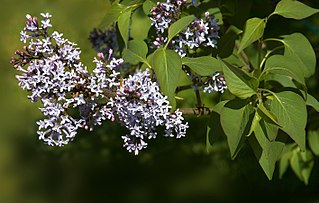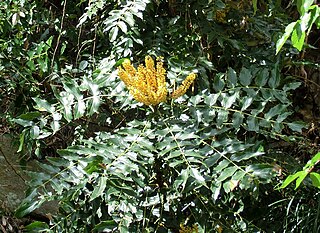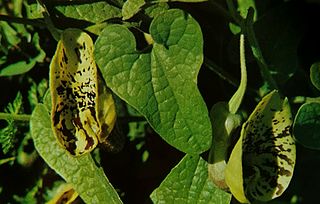
Mahonia is a formerly accepted genus of approximately 70 species of shrubs or, rarely, small trees with evergreen leaves in the family Berberidaceae, native to eastern Asia, the Himalaya, North America, and Central America. They are closely related to the genus Berberis and as of 2023 the majority of botanical sources list it as a synonym for Berberis.

Rhamnus is a genus of about 140 accepted species of shrubs or small trees, commonly known as buckthorns, in the family Rhamnaceae. Its species range from 1 to 10 m tall and are native mainly in east Asia and North America, but found throughout the temperate and subtropical Northern Hemisphere, and also more locally in the subtropical Southern Hemisphere in parts of Africa and South America. One species, the common buckthorn, is able to flourish as an invasive plant in parts of Canada and the U.S., where it has become naturalized.

Syringa komarowii is a species of lilac native to central China, commonly called nodding lilac. It is native to the Provinces of Gansu, Hubei, Shaanxi, Sichuan, Yunnan.

Juniperus excelsa, commonly called the Greek juniper, is a juniper found throughout the eastern Mediterranean, from northeastern Greece and southern Bulgaria across Turkey to Syria and Lebanon, Jordan, the Caucasus mountains, and southern coast of Crimea.
Ulmus bergmannianaC.K.Schneid., commonly known as Bergmann's elm, is a deciduous tree found across much of China in forests at elevations of 1500–3000 m.
Camillo Karl Schneider was a German botanist and landscape architect. A farmer's son, he was born at Gröppendorf, in the Kingdom of Saxony, and worked as a gardener at Zeitz, Dresden, Berlin and Greifswald. Returning to Berlin to work in the City Parks Department, he assisted in editorial work for the periodical Gartenwelt, which led to his employ as a landscape assistant in Darmstadt and Berlin. In 1900, he moved to Vienna, where he practiced as a freelance architect and writer, travelling extensively through Europe. In 1904 he published his first books, including the beginning of his tome Illustrated Handbook of Broad-leaved Trees, which he completed in 1912. However, the manuscript of what should have been his magnum opus, a study of the genus Berberis, was destroyed in a bombing raid on Berlin in 1943. In 1907 he created the specimen series Plantae hungaricae 1907 distributed as an exsiccata-like series.

Al Shouf Cedar Nature Reserve is a nature reserve in the Chouf and Aley districts of Lebanon. It is located on the slopes of Jebel Baruk mountain and has an area of 550 km2 (210 sq mi), nearly 5.3% of the Lebanese territory, making it the largest natural reserve in Lebanon.

Berberis candidula is a species of plant in the family Berberidaceae. It is endemic to China, native to the provinces of Hubei and Sichuan. It is commonly known as paleleaf barberry.
Berberis decipiens is a species of shrub in the Berberidaceae described as a species in 1913. It is endemic to Hubei Province in China. The species is listed as vulnerable by the IUCN.
Berberis fordii is a species of shrub in the Berberidaceae described as a species in 1913. It is endemic to China, found in Chongqing and Guangdong Provinces.

Berberis napaulensis Nepali: जमाने मान्द्रो is a shrub in the family Berberidaceae described as a species in 1821. It is native to China and the Himalayas. This species is used medicinally throughout the Sikkim Eastern Himalayas.
Berberis schochii is a shrub in the Berberidaceae described as a species in 1913. It is endemic to China, known from the provinces of Guizhou and Sichuan.
Berberis sheridaniana is a shrub in the Berberidaceae described as a species in 1913. It is endemic to China, found in the provinces of Hubei and Sichuan.
Berberis weberbaueri is a shrub in the Berberidaceae described as a species in 1908. It is endemic to Peru, found in the regions of Ancash, Cajamarca, La Libertad, and Lambayeque.
Berberis arguta is a shrub in the Berberidaceae described as a species in 1908, having been first described in 1886 at the "forma" level. It is endemic to China and is found only in the Province of Yunnan in southwestern China.

Aristolochia delavayi, known as the party-colored birthwort, is a species of flowering plant in the family Aristolochiaceae.

Eminium spiculatum is a species of plant in the family Araceae.

Veronica syriaca, the Syrian speedwell, is a flowering plant species in the family Plantaginaceae. The generic name of this flower is of unknown origin. Some think it is a distortion of betonica, the Latin name of a species of Labiates; others consider that it refers to Saint Veronica who handed a cloth to Christ to wipe the perspiration from his face.

Colchicum stevenii, or Steven's meadow saffron, is a species of flowering plant in the family Colchicaceae. Hebrew: סתוונית היורה, Arabic: سَراجُ الغولة, سُورَنْجان

Erodium acaule is a species of plant in the family Geraniaceae.













